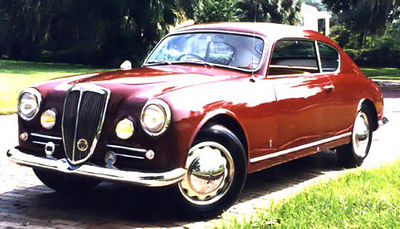Difference between revisions of "Lancia Aurelia"
m |
m |
||
| Line 1: | Line 1: | ||
| − | + | ||
{| border=1 align="right" cellpadding=2 cellspacing=0 width=250 style="margin-left:3em; margin-bottom: 2em;" | {| border=1 align="right" cellpadding=2 cellspacing=0 width=250 style="margin-left:3em; margin-bottom: 2em;" | ||
|- | |- | ||
Revision as of 20:04, 2 October 2007

| |
| Lancia Aurelia | |
|---|---|
| Production: | 1950-1958 |
| Successor: | Lancia Flaminia |
| Manufacturer: | Lancia |
| Class: | Grand tourer |
| Body_Style: | 2-door convertible 2-door coupé 4-door sedan |
| Designer: | Vittorio Jano |
| engine: | 1.8 L 1800 V6 2.0 L 2000 V6 2.5 L 2500 V6 |
The Lancia Aurelia is considered by many to be the first true Grand Turismo automobile. Designed by Vittorio Jano, the Aurelia was launched in 1950 and production lasted through the summer of 1958.
The Aurelia used the first production V6 engine, a 60° Jano design which grew from 1.8 L to 2.5 L. It was an all-alloy pushrod design with a single camshaft between the cylinder banks. A hemispherical combustion chamber and inline valves were used. A single Weber 40 carburetor completed the engine.
At the rear was an innovative combination transaxle with the gearbox, clutch, differential, and inboard-mounted drum brakes. Front suspension was a sliding pillar design, with rear semi-trailing arms replaced by a de Dion tube in the 4th series.
1st series
The very first Aurelias were the B10 berlinas. They used a 1754 cc version of the V6 which produced 56 hp. The B21 was released in 1951 with a larger 1991 cc 70 hp engine. A 2-door B20 GT Coupe appeared that same year. It had a shorter wheelbase and a Ghia-designed, Pininfarina-built body. The same 1991 cc engine produced 75 hp in the B20. In all, 500 first-series Aurelias were produced.
2nd series
The second series Aurelia coupe pushed power up to 80 hp from the 1991 cc V6 with a higher compression ratio and repositioned valves. Other changes included better brakes and minor styling tweaks. A new B22 berlina was released in 1952 with dual Webers and a hotter camshaft for 90 hp.
3rd series
The 3rd series appeared in 1953 with a larger 2451 cc version of the engine. The rear of the car lost the tail fins of the earlier series, but was well resolved in an elegant and definitive look for the Aurelia coupe.
4th series
The 4th series introduced the new de Dion tube rear suspension. The engine was changed from white metal bearings to shell bearings. An open car, the stunning B24 Spider was introduced at this time (1954-55) and was well received. It was similar to the 4th s. B20 coupe mechanically, with 8" less wheelbase than the coupe.
5th series
The 5th series coupes, appearing in 1956, was more luxury-oriented. It had a different transaxle (split case), which was more robust and similar to that used in the later Flaminias. The dirve shaft was also revised to reduce vibration.
Along side the fifth series coupes was a revised open car, the B24 Convertible. This differed from the earlier (4th series) B24 Spider, having roll up windows and better seating position, a windscreen with vent windows. In mechanical aspects, the B24 convertible was similar to the coupe of the same series.
6th series
Power was down to 112 hp for the 1957 sixth series.
| Lancia S.p.A.
|
||
|
037 / Rally | Appia | Aprilia | Ardea | Artena | Astura | Augusta (1932-1937) | Aurelia | Beta | Dedra | Delta (1979-1994) | Dilamda (1928-1938) | Fulvia Dunja (1971) | Flaminia | Flavia | Fulvia (1963-1976) | Gamma | Hyena | Kappa | Lambda (1922-1931) | Lybra | Monte Carlo | Prisma (1982-1990) | Pagani (1947) | Phedra | Stratos | Thema | Thesis (2001-) | Y10 | Zagato | Zeta | Ypsilon | ||
